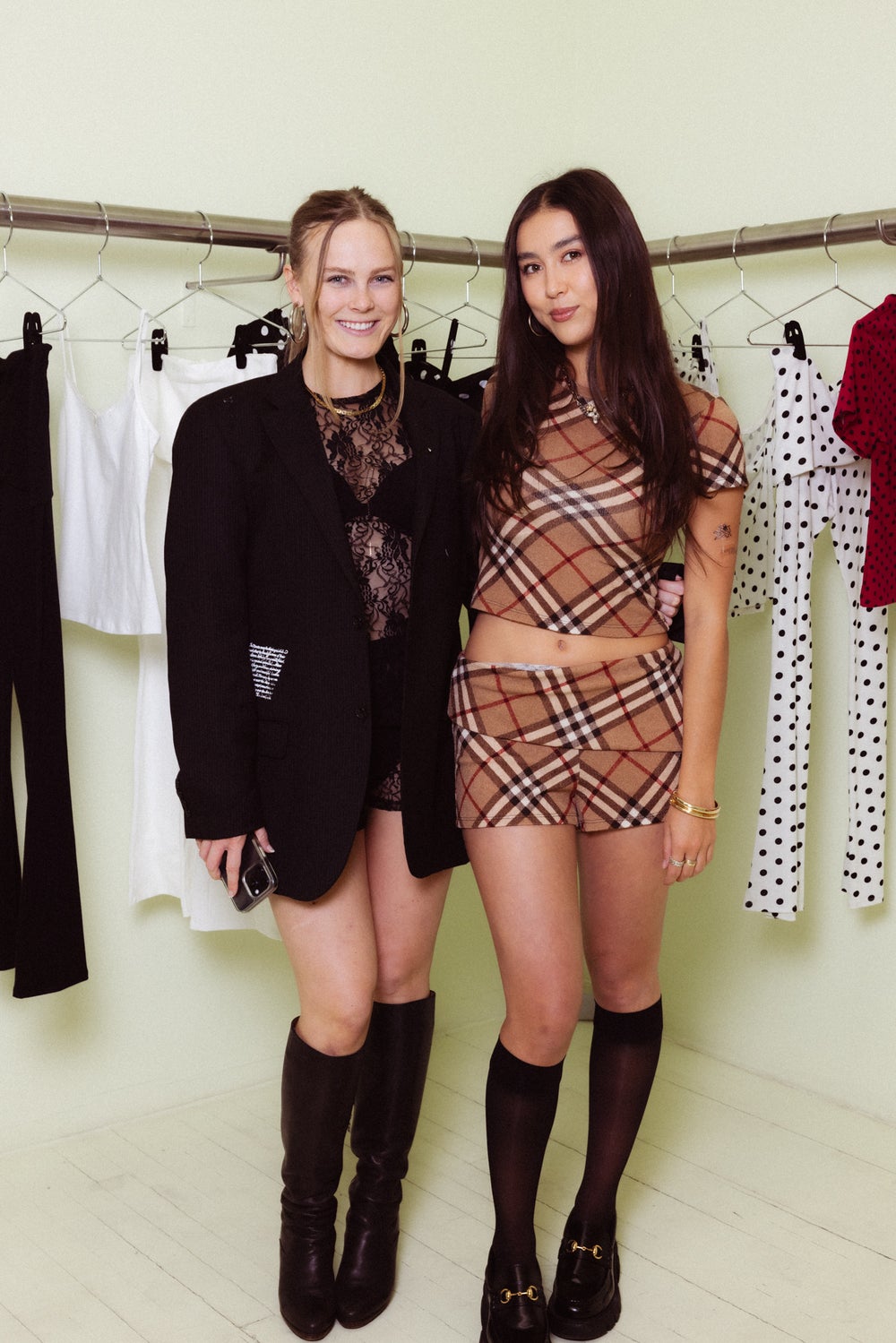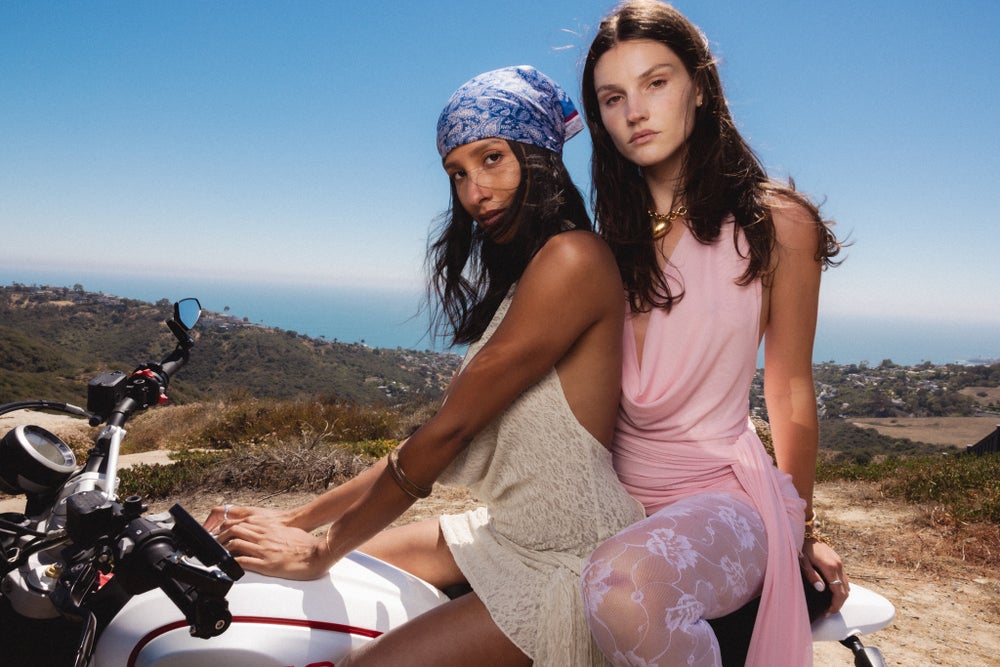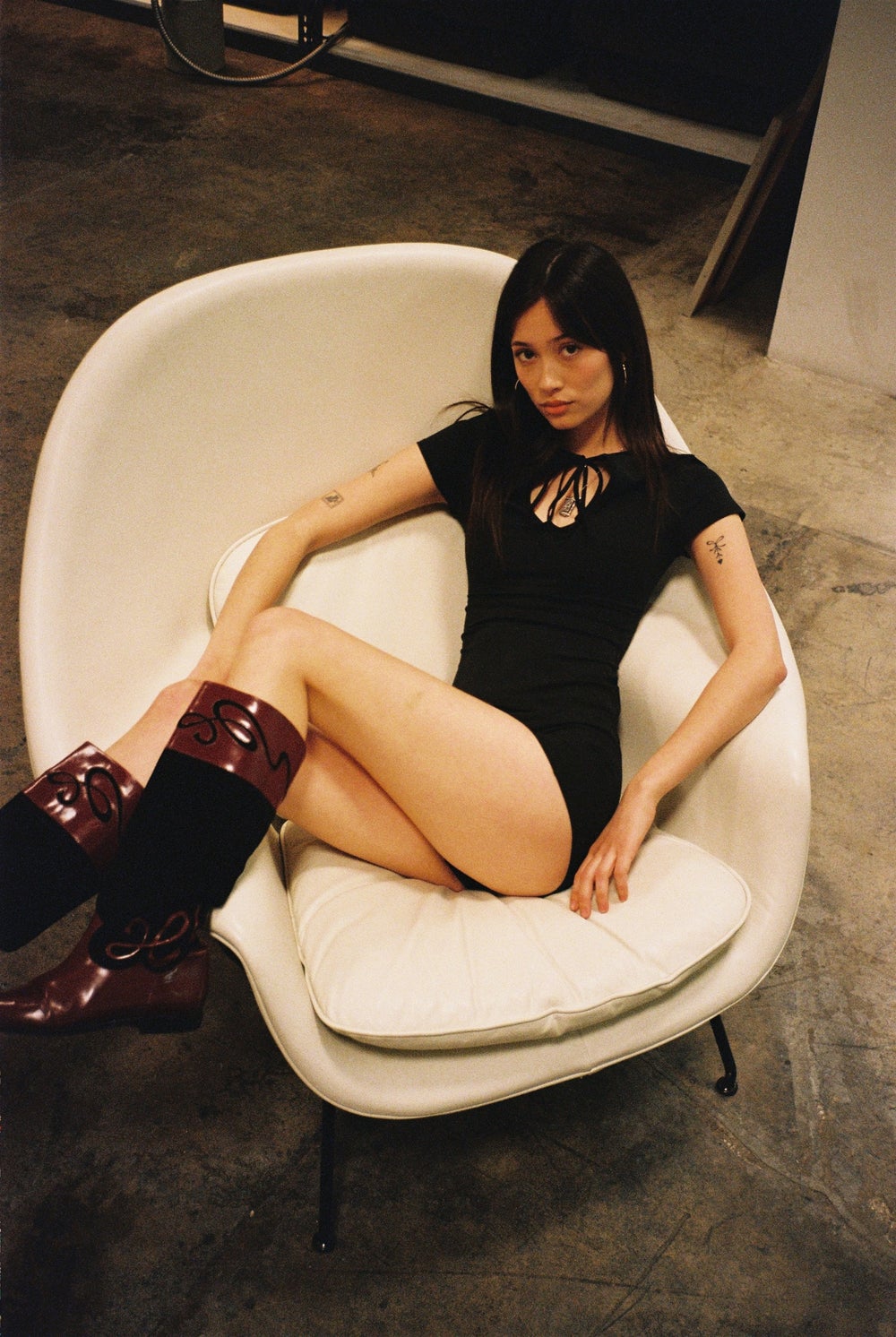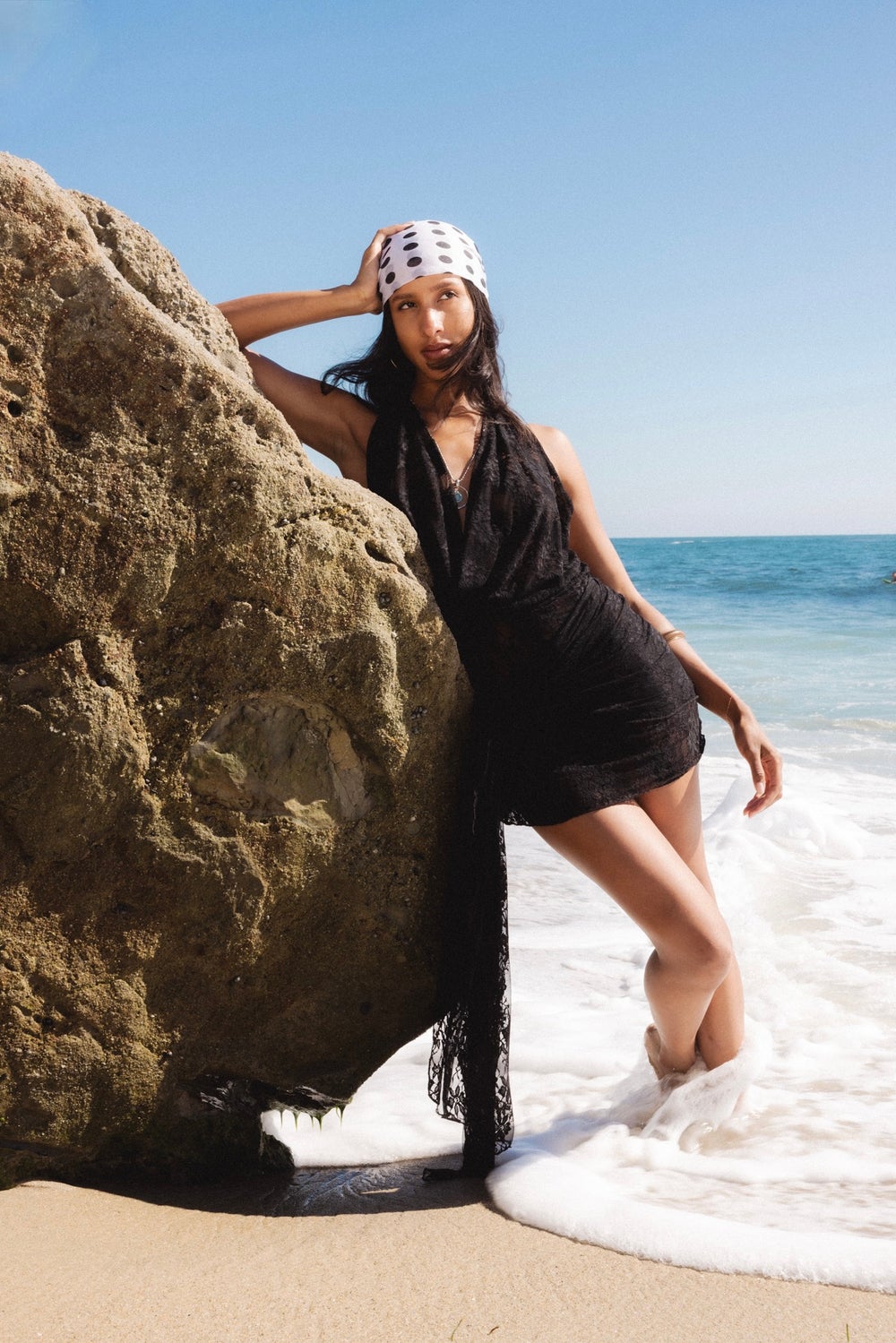Key Takeaways
- Campbell and Kramer started a womenswear basics apparel brand out of a UCLA dorm room in 2019.
- Here’s how they transformed a $50 thrift store purchase into a successful brand on track for $500,000.
This Side Hustle Spotlight Q&A features Los Angeles, California-based entrepreneurs Presley Campbell, 25, and Alden Kramer, 25. Campbell and Kramer are the co-founders of womenswear basics apparel brand Campbell&Kramer, which they launched out of their college dorm room in 2019. Responses have been edited for length and clarity.

Image Credit: Courtesy of Campbell&Kramer. Alden Kramer, left, and Presley Campbell, right.
Want to read more stories like this? Subscribe to Money Makers, our free newsletter packed with creative side hustle ideas and successful strategies. Sign up here.
What was your day job or primary occupation when you started your side hustle?
Presley: When Alden and I started our side hustle, we were both college students, freshmen at UCLA. I also worked in sales and consulting at a secondhand fashion resale app.
Alden: I also worked in real estate investing, architecture and design.
Related: Couple’s Side Hustle Surpassed $1,000 a Day Fast — With ChatGPT’s Help
When did you start your side hustle, and where did you find the inspiration for it?
Presley: We started our side hustle in the spring of 2019, sewing thrifted fabrics out of our UCLA freshmen year dorm room. I initially found inspiration to start a sustainable line while in a sustainability course. I learned about the horrors of fast fashion in depth for the first time, and it completely altered my perception of the fashion industry. Since I was little, I looked up to my mom and aunt, who both worked in designer fashion and have the most iconic taste and vintage archives, and my dad, who’s an entrepreneur.
Alden and I were also in a sustainable fashion internship for a resale app freshman year, and we watched The True Cost, a documentary that focuses on fast fashion, together. We created our brand mission and a logo that night, sitting on our twin XL dorm beds. We wanted to build a brand that repurposed existing materials, creating pieces women our age wanted to wear at an affordable price point.

Image Credit: Courtesy of Campbell&Kramer
Alden: I have always wanted to create a fashion brand — since third grade. It’s an obsession that stems from really ordinary and scattered muses: from films like The Lizzie McGuire Movie and Confessions of a Teenage Drama Queen to toys like Polly Pockets and Barbies to music from Taylor Swift and Lana Del Ray to magazines and books like Teen Vogue and The Clique. Also, my grandmother taught home economics and was a talented seamstress. She had a sewing room stuffed with fabrics, trims and all types of machines. Naturally, I asked my grandma to teach me to sew; her lessons didn’t refine my technical talent, but they fostered more interest in the end product. When I met Presley during our freshman year at UCLA, I was so grateful that someone else loved fashion as much as I did. More importantly, Presley brought a new perspective that added to my own, and she was just as eager to do something about the passion: She also wanted to build something.
What were some of the first steps you took to get your side hustle off the ground? How much money/investment did it take to launch?
Presley: We were 19-year-old college students with no prior business experience, but we immediately took action toward our idea and never looked back. We took very small, actionable steps to start, bringing $50 to the local thrift store and purchasing some larger blankets and old rolls of fabric to sew our designs. At the time, this felt like a lot of money to us. We sold these pieces to family and friends around campus. Family friends then donated old UCLA gear to us, and we upcycled it into game day apparel, which we sold around campus and at our sororities. Our community truly was everything to us, and still is.
During the pandemic, we had a local Orange County influencer, Ella McFadin, post in our hand-dyed tie-dye thrifted sweat sets. The impact was enormous. We instantly sold out and had an influencer and celebrity domino effect ensue. Huge names were sliding in our DMs left and right, and we couldn’t keep up with the demand. We were hand-dyeing and hand-sewing hundreds of pieces out of our family homes in Orange County during lockdown, and eventually raised enough to partner with a local LA factory to help us keep up with demand. Once we graduated, we really wanted to re-focus the brand on our original vision of elevated basics made from pre-existing materials such as deadstock or recycled fabric. There is enough amazing, beautiful fabric already in circulation, and we strongly believe there’s no need to make anything “new.”
If you could go back in your business journey and change one process or approach, what would it be, and how do you wish you’d done it differently?
Presley: This is a hard one because at the end of the day, I’m grateful for all the mistakes we’ve made. They’ve taught us invaluable lessons that have led us to where we are today. However, we partnered with a few questionable factories when we first started due to a lack of knowledge. We were students with no prior experience and were cold-calling any factories in LA that would entertain such low minimum quantities. After a few very wrong turns, we finally found a patternmaker who’s very well connected with factories in LA. She completely changed the game for us, and we couldn’t be more grateful to learn from and grow alongside her. I would recommend speaking with multiple professionals in the industry so you know what to look for and vetting any potential partners extensively.
Alden: I am someone who has to learn from experience rather than just follow advice. Mistakes have brought us a lot of perspective, and I believe that knowing what doesn’t work is just as valuable as knowing what does work.
Related: His Salty Side Hustle Saw Revenue ‘From Day 1’ and Hit $10 Million Last Year
When it comes to this specific business, what is something you’ve found particularly challenging and/or surprising that people who get into this type of work should be prepared for, but likely aren’t?
Alden: Fashion always seemed more frivolous and artful to me instead of data-driven and operationally advanced. That’s obviously not the case. In order to have a successful business, you need a strong and modern operational foundation, and in order to grow, you need metrics and insights, regardless of what industry you’re in. That’s something that we’re adjusting to. We did business quite casually and didn’t have organizational systems or key metrics that we tracked. But as we grow, we understand the need to streamline operations, centralize data collection and critically compare revenue and expenses.
Presley: When we first started, we were very focused on our designs and establishing our website and social media presence. We didn’t think through establishing the organization behind it all, the number of SKUs we would go on to have, tracking inventory across numerous locations now that we work with boutiques, showrooms and stylist loans, tracking data from our audience behaviors, etc. This is something we are continuously improving, and anyone looking to start a brand should make it a priority from the beginning.

Image Credit: Courtesy of Campbell&Kramer
Can you recall a specific instance when something went very wrong? How did you fix it?
Presley: Quite a few. But it never feels dire because Alden is there for me (and I her). We accept the issue and immediately propose solutions. The first factory we paired with produced our units several sizes too small. They fit my elementary school-aged siblings. And it was such a large amount of money for us. This mistake really taught us to perfect patterns, run that extra sample rather than jump to production and only work with partners we really trust.
Alden: To second Presley, any time an issue does come our way, we really try to rationally work through it and not panic: We both understand that stressing out about something isn’t going to solve it.
How long did it take you to see consistent monthly revenue? How much did the side hustle earn?
Presley: For the first few years, we had sporadic revenue. We were full-time students, so sometimes we would have more time to focus on C&K than others. Some months we made $25,000 (and had to hand-sew/dye hundreds of pieces ourselves), and others $2,000. We ran every single part of the business ourselves. In the past two years, we’ve started seeing consistent monthly revenue. This past year, our monthly revenue has significantly increased as we’ve taken the leap into wholesale.
Alden: Inconsistent revenue was also a result of inconsistent product and timing. We’ve really focused our product selection on womenswear basics and have a more consistent supply than in our earlier years.
Related: This Mom’s Garage Side Hustle for Kids Became a Business With $1 Billion Revenue
What does growth and revenue look like now?
Presley: This past year, we’ve experienced significant growth. We began experimenting with wholesaling earlier this year, and we landed our first major retailer wholesale collaboration with Urban Outfitters and began selling to quite a few boutiques around the country. We bootstrapped our first wholesale market ourselves, and it went very well. Now we have wholesale partners and are excited to continue growing that side of the business. Our projected revenue for 2025 is around $500,000.
Alden: Growth looks like steadily scaling our existing channels: direct to consumer, boutiques and larger retailers. We like working with boutiques and want to expand that channel. The orders are more casual, frequent and flexible, and we love having our product in hyper-local places.
What do you enjoy most about running this business?
Presley: I love every aspect of running this business with my best friend. I find myself reflecting on how grateful I am to be working toward my dream every day. We are both so passionate about this brand, so it never truly feels like work. Building Campbell&Kramer is the most fun journey. It’s beautiful to watch the entire creative process come to life, from a sketch or vintage inspo to first samples to photoshoot concepts to social strategies and launch events. I love seeing our customers in the pieces we’ve worked so long on. I love designing for other women our age, and every age. It’s so fulfilling to know we are helping women feel their most confident and that people all over the world are strutting around in C&K, making memories in their pieces.
Alden: First, sharing this journey with my best friend. We both push each other. We celebrate our successes together. We share failures and motivate each other to move on. In general, I’m so thankful for someone who cares as much about a passion as I do and with whom I can work so compatibly and trust. Second, developing a vision and watching it come to life. That is so fulfilling. We have so much fun sourcing and bringing on other talent to help execute the vision, too. Finally, the mission. We truly believe in creating hyper-wearable garments that really flatter the customer, don’t sit in your closet, complement what you already have and, most importantly, come from existing materials only.

Image Credit: Courtesy of Campbell&Kramer
What is your best piece of specific, actionable business advice?
Presley: There will never be a perfect time to start. So start now. Dive in headfirst and never look back. Even if it’s the smallest step, create a logo (you can always change it later) and make the Instagram account. Start posting about what you’re building so people can get invested early on, and draw upon your community for support. You can’t be afraid to put yourself or your ideas out there and to reach out to everyone in your network or people online who are knowledgeable in the space. Learn from them and ask so many questions (even ones you may think are obvious). Everyone is capable of achieving their dreams if they act on their ideas and never give up. Pivot when you fail until you find what works. Most importantly, find a partner or team who you adore, trust and want to spend immeasurable amounts of time with. Write down your goals and actively work toward them day in and day out.
Alden: One thing I need to remember is that everything comes from one small step forward. I tend to build a huge scope in my head and create something audacious and impossible to tackle, to the point where I’m left asking, Where do I even start? Start small. Just do one thing at a time, and everything will compound.
This article is part of our ongoing Young Entrepreneur® series highlighting the stories, challenges and triumphs of being a young business owner.
Key Takeaways
- Campbell and Kramer started a womenswear basics apparel brand out of a UCLA dorm room in 2019.
- Here’s how they transformed a $50 thrift store purchase into a successful brand on track for $500,000.
This Side Hustle Spotlight Q&A features Los Angeles, California-based entrepreneurs Presley Campbell, 25, and Alden Kramer, 25. Campbell and Kramer are the co-founders of womenswear basics apparel brand Campbell&Kramer, which they launched out of their college dorm room in 2019. Responses have been edited for length and clarity.

Image Credit: Courtesy of Campbell&Kramer. Alden Kramer, left, and Presley Campbell, right.
Want to read more stories like this? Subscribe to Money Makers, our free newsletter packed with creative side hustle ideas and successful strategies. Sign up here.
